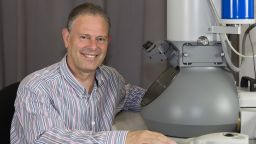About Materials Science and Engineering
Our history can be traced back to 1882, and has seen a number of significant developments in the field of Materials Science and Engineering.

History
The Department of Materials Science and Engineering was formed in 1879 and is housed in the Sir Robert Hadfield Building. The School of Materials - as it was then known - amalgamated the Department of Metallurgy and the Department of Ceramics, Glasses and Polymers, and has since become one of the largest centres for materials research in the UK, providing a focus for research innovation and collaboration. In 2024, it became part of the School of Chemical, Materials and Biomedical Engineering.
Our excellence in teaching has been recognised nationally - awarded 22 out of a possible 24 in the HEFCE teaching quality assessment - and our research-led teaching is at the forefront of current knowledge, making our department a stimulating environment in which to study.
Wide-ranging academic excellence
Many major research breakthroughs have been made in Sheffield Materials Research Centres, such as the discovery of polymer electrolytes and establishing the role between thermomechanical processing and carbo-nitride precipitation in steels. Here are some more recent findings:
A technique to mass produce lightweight steel has been developed by a team led by Professor Mark Rainforth. The secret behind this success is the inclusion of copper - an element which is traditionally avoided in steel production. In addition to the production of high strength lightweight steel, this method incorporates a greater proportion of recycled steel making it much more sustainable.
The research leading to the discovery was published in Nature.
The first report of a liquid quasicrystal was made by Professor Ungar and Dr Zeng in 2004. This work describes a new state of soft matter possessing long-range order while lacking periodicity and having crystallographically-forbidden 12-fold symmetry. The finding points the way towards the creation of wide photonic bandgap materials through supramolecular self-assembly.
Supramolecular dendritic liquid quasicrystals, Letters to Nature, 428, (2004), 157-160.
Recently in collaboration with colleagues at Imperial College, London and the University of Cambridge, we have demonstrated a three-terminal logical NOT-gate made from magnetic nanowires. The device will be useful for creating parallel read-out of magnetic shift registers and in nanowire logic more generally for combining the NOT and signal amplification functions in a single element.
Magnetic domain wall serial-in parallel-out shift register, Appl. Phys. lett., 89, (2006), 102504-1-102504-3
An in-situ TEM nano-indenter capable of creating local deformation while simultaneously observing the deformation mechanics by TEM has been designed and fabricated. It can measure small forces of the order of 1µN.
A miniaturized TEM nanoindenter for studying material deformation in-situ, Meas. Sci. Technol., 17, (2006), 1324-1329.

